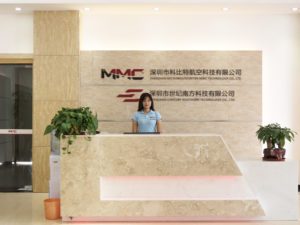
— Sponsored by MMC
As a follow-up to a recent trip to MMC’s new production and offices in Boa’an Shenzhen China, I wanted to understand the reasons why Chinese companies are so dominant in the manufacturing portion of the drone industry and does that help Chinese drone manufactures to be successful.
A March 2015 article from The Economist on Chinese Manufacturing stated that in 1990 China had < 3% of world manufacturing but by 2015 that percentage had risen to 25%. China currently manufactures 80% of the world’s air conditioners, and 70% of its mobile phones. When you realize that chip manufactures such as Intel, Qualcomm, and others are racing to take advantage of the opportunities in the Drone space you realize that this type of rapidly innovating technology products with a multitude of chips and sensors are very well suited to Drones.
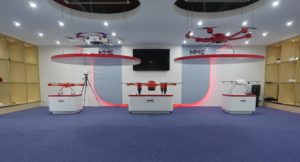
Drone manufacturing is primarily located in China. There are a number of reasons for this that you may be aware of, lower labor costs, a very friendly governmental regulatory environment, more focus on manufacturing, manufacturing cartels, and others.
Players such as DJI, Yuneec, MMC, all have Chinese based manufacturing and many combine manufacturing, design, testing, and customer service and support. The vast majority of the lower end manufacturers of consumer drones are both based and are manufactured in China. Let’s explore eight of the reasons why?
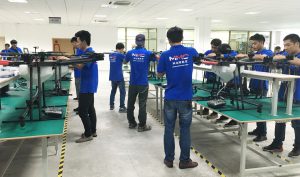
China does manufacturing differently:
- Flatter Processes: A flatter more efficient build process that includes design, build, and testing. Using MMC as an example, the design team of about 20 people worked with various CAD systems on the design of each of the drones produced. This is done in a single large room, with what appeared to be a high degree of collaboration (my Chinese skills are very much lacking or I would share more on this). This design/R&D work is done in very close proximity with the manufacturing and testing teams. In this case, on the same physical building and on the same floor. Being in the same complex (physical location) allows for better communication and exchange of ideas between the various design, build and testing elements. This seems to reduces cycle time between design, production, and repair.

- Components Frames: For most high end Drones Carbon Fiber is used, if you are not familiar with Carbon Fiber it is manufactured product that includes very thin sheets of carbon fiber that are stiffened by a very small amount of resin. The result of which is very light and very strong, both good things for a drone to be especially a commercial drone where long flight times, and the ability to carry a heavy payload matters. I had a chance to spend some time with a translator with Mr. Arvin Deng who is in charge of frame production at MMC. A man of about 35, Deng was clearly very proud of his products and the factory where they were produced. His background is in the manufacture of high end car parts (carbon fiber being light and very strong is also used in high end car manufacturing as it helps to reduce weight, the same thing that makes it so useful in producing Drones). The process includes molds for the various frames, that are created with a combination of fiber, resin, and heat the details of which is kept a trade secret. The Drone frames themselves are quite large, often the size of a coffee or even a dining room table but are almost unbelievably light, when you pick up a frame it almost fools the senses as if something that large could be so light. As I interviewed with the aid of a translator, Mr. Deng, entertained me with serving me a traditional tea ceremony but using a carbon fiber tray of his own design and manufacture. Really cool. Carbon fiber, while being light and strong, is also expensive and its manufacture is labor intensive and is hand finished, both advantages in China rather than elsewhere.
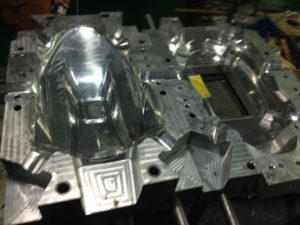
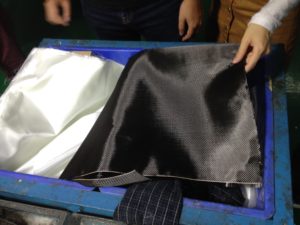
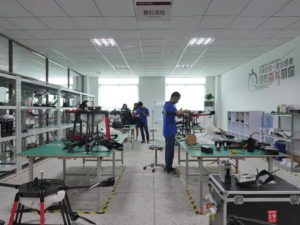

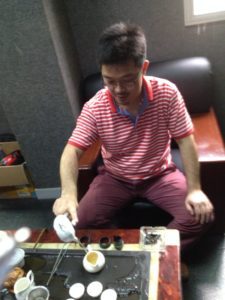
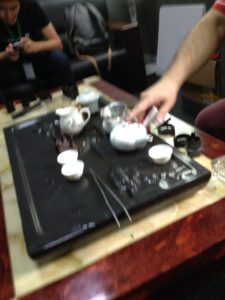
- Short Design cycles lead to Rapid improvements: They told me that design cycles seem to run in about 90 day cycles, especially with a new model of drone. The manufacturing process of assembly and then flight testing often leads to small but important design improvements such a locking screw that both allows the arm to stay attached to the drone but allow easy replacement of an arm should that be needed.

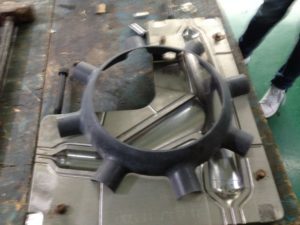
- Testing cycles for new models and enhancements: This showed a real difference that I was able to see first hand, when showing me the hydrogen drone MMC launches Hydrogen Drone they were testing out a new model of that Drone as I was touring the factory. They took the Drone up onto the roof of the manufacturing building, and did a test flight on the spot. I was told that this is sometimes done up to several times a day depending upon what is being testing. Contrast this with manufacturing in the US where testing would be scheduled for a test site, often in a remote area. Image if a company in the US had tested the drone in an urban environment you can image the resulting visits from the local police, state and federal law enforcement, and accompanying FAA involvement with the almost certainly of a huge fine. It is just not conceivable that this be done in the US. I spend some time asking about this to my hosts from MMC about the risks, and left feeling that they were not irresponsible but rather there is a culturally a different tolerance to possible risk. MMC was very careful, made sure that they were out of the way of planes, worked very closely with local officials, and were very exacting when flying the drones that safety measures be followed. But it was striking, rather than weeks or months, companies like MMC shorten this cycle to days.
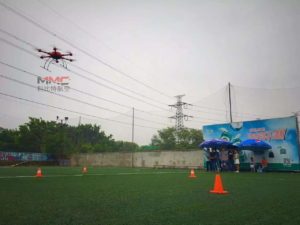
- Favorable Infrastructure: China invests more in infrastructure than most countries. According to a recent Mckinsey study China invests more in infrastructure and either the US or Europe. Other studies have noted that they are building 10 new airports per year through 2020, any visitor to Shenzhen or other economic development areas of China, can not come away impressed by the rate and scale of economic development. Building is occurring everywhere.
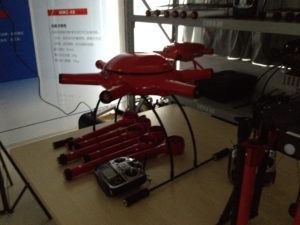
- Features and Functions: have direct sales and support allows MMC and companies like them, to incorporate customer features in a rapid design environment. Features such as double GPS sensors allow for stronger and more accurate satellite signal and positioning. A payload connector that allows for easy transfer and switch payloads, and their own software and ground station were all as a result of client feedback.
- Corroboration: While Chinese firms most certainly compete with one another, they do take advantage of production efficiencies. As an example, MMC manufactures carbon fiber frames for other companies in their manufacturing facility.
- Openness: This is hard to quantify but important, when speaking to the production team at MMC they were very open, allowed me to freely take photos and interview anyone that I wished. When I asked about this they laughed, and through a translator told me that building drones was difficult and they did not believe that other companies would be able to duplicate the process in a way that would threatening them. Deng said. “ by the time they would be able to duplicate a particular feature, we would have already moved on to the next thing.”
According the Economist and others, China is likely to continue to have an advantage in manufacturing for the foreseeable future. While their standard of living increases may push out the lowest value manufacturing (think plastic cups) the competitive advantage of China in Drone manufacturing is likely to continue and it will only help Chinese drone manufactures.
 Unmanned Aerial Vehicle The latest drone news
Unmanned Aerial Vehicle The latest drone news


